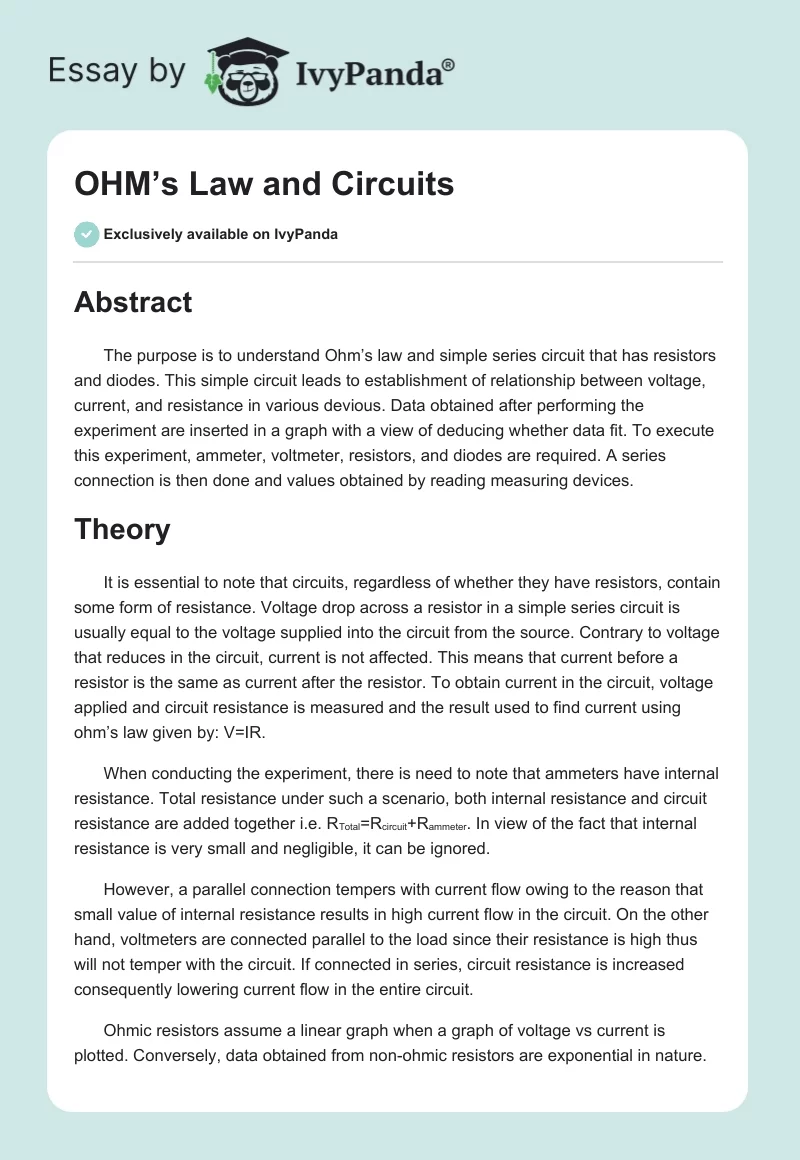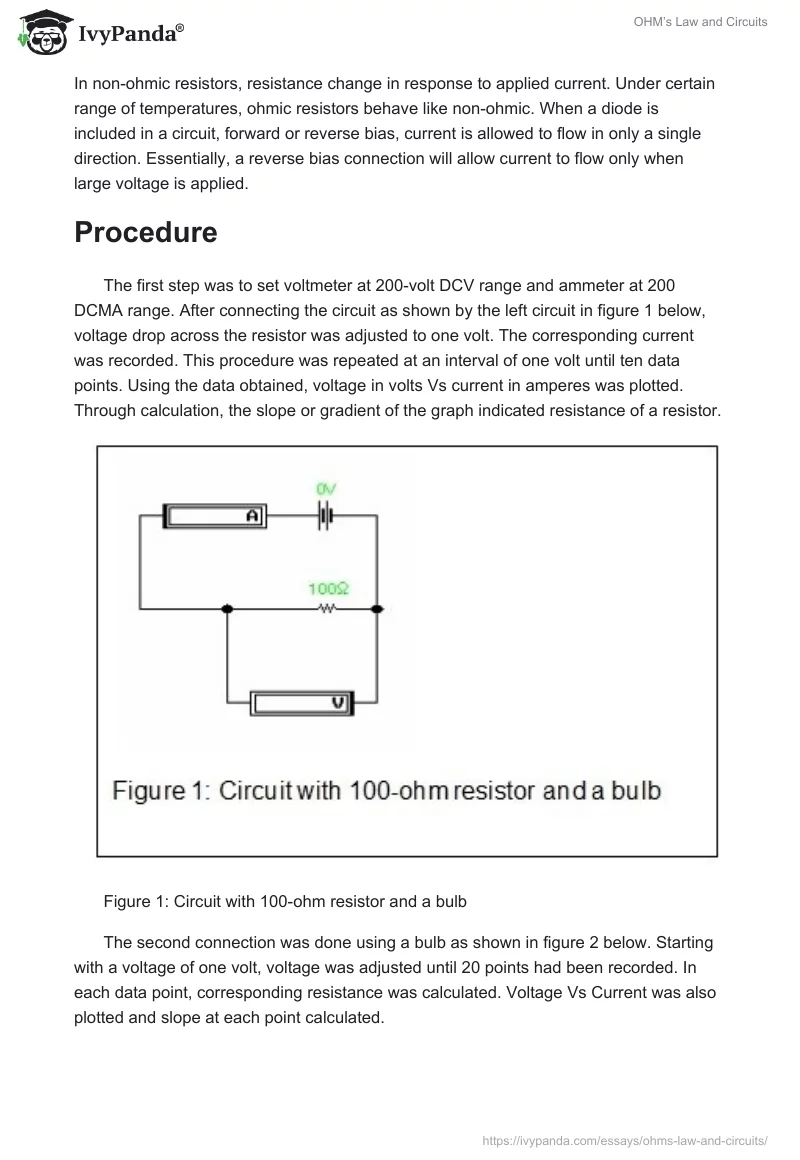Abstract
The purpose is to understand Ohm’s law and simple series circuit that has resistors and diodes. This simple circuit leads to establishment of relationship between voltage, current, and resistance in various devious. Data obtained after performing the experiment are inserted in a graph with a view of deducing whether data fit. To execute this experiment, ammeter, voltmeter, resistors, and diodes are required. A series connection is then done and values obtained by reading measuring devices.
Theory
It is essential to note that circuits, regardless of whether they have resistors, contain some form of resistance. Voltage drop across a resistor in a simple series circuit is usually equal to the voltage supplied into the circuit from the source. Contrary to voltage that reduces in the circuit, current is not affected. This means that current before a resistor is the same as current after the resistor. To obtain current in the circuit, voltage applied and circuit resistance is measured and the result used to find current using ohm’s law given by: V=IR.
When conducting the experiment, there is need to note that ammeters have internal resistance. Total resistance under such a scenario, both internal resistance and circuit resistance are added together i.e. RTotal=Rcircuit+Rammeter. In view of the fact that internal resistance is very small and negligible, it can be ignored.
However, a parallel connection tempers with current flow owing to the reason that small value of internal resistance results in high current flow in the circuit. On the other hand, voltmeters are connected parallel to the load since their resistance is high thus will not temper with the circuit. If connected in series, circuit resistance is increased consequently lowering current flow in the entire circuit.
Ohmic resistors assume a linear graph when a graph of voltage vs current is plotted. Conversely, data obtained from non-ohmic resistors are exponential in nature. In non-ohmic resistors, resistance change in response to applied current. Under certain range of temperatures, ohmic resistors behave like non-ohmic. When a diode is included in a circuit, forward or reverse bias, current is allowed to flow in only a single direction. Essentially, a reverse bias connection will allow current to flow only when large voltage is applied.
Procedure
The first step was to set voltmeter at 200-volt DCV range and ammeter at 200 DCMA range. After connecting the circuit as shown by the left circuit in figure 1 below, voltage drop across the resistor was adjusted to one volt. The corresponding current was recorded. This procedure was repeated at an interval of one volt until ten data points. Using the data obtained, voltage in volts Vs current in amperes was plotted. Through calculation, the slope or gradient of the graph indicated resistance of a resistor.
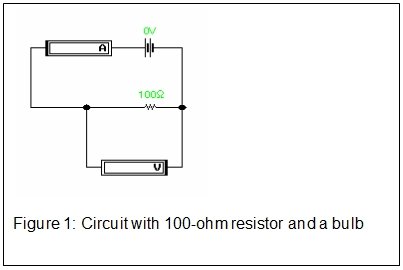
Figure 1: Circuit with 100-ohm resistor and a bulb
The second connection was done using a bulb as shown in figure 2 below. Starting with a voltage of one volt, voltage was adjusted until 20 points had been recorded. In each data point, corresponding resistance was calculated. Voltage Vs Current was also plotted and slope at each point calculated.
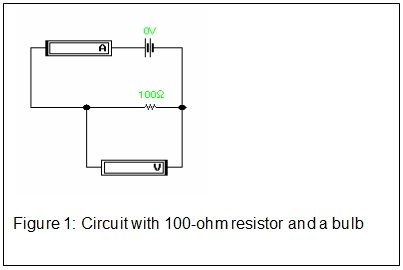
Figure 2: circuit with a bulb
The third step was a circuit connection with a forward biased diode included as shown in figure 3. Voltage was applied starting with 0.1 volts and increased at an interval of 0.1 volts.

Figure 3: Forward biased diode
The fourth circuit connection was a reverse diode shown in figure 4 below. Applied voltage was varied at an interval of 2 volts starting with 1 volt. Ten data points were recorded to aid in analysis.
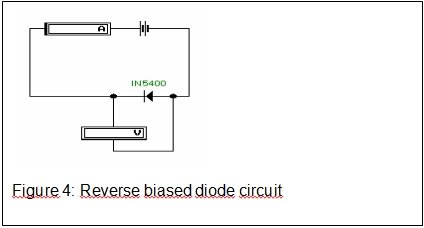
Figure 4: Reverse biased diode circuit

 4.28
4.28